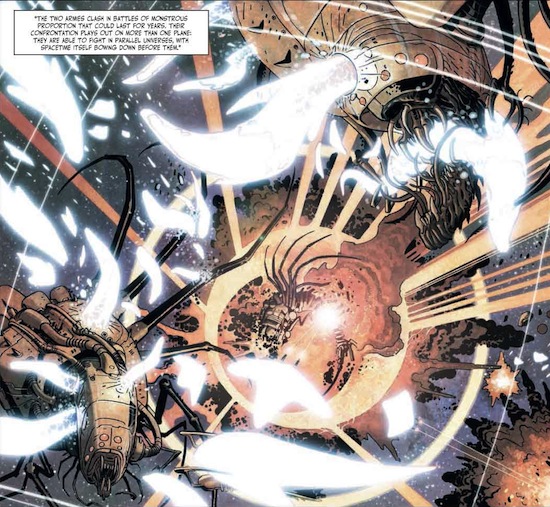Legendary French publishing house, Les Humanoïdes Associés, has been celebrating its 40th anniversary this year. To commemorate such a milestone, in true Humanoids style, they’ve been releasing new editions of old classics as well as fascinating new adventures, making sure the books are beautiful to hold and behold. While the U.S. office and now parent company, Humanoids Inc., has been running since 1998, 2014 also sees the launch of Humanoids UK as well as opening for business in Japan. LHA/Humanoids have continually introduced strong talents and published powerful stories that not only entertain but also entice the reader into new worlds that expand the possibilities of our own.
In Paris 1974, artists Moebius (Jean Giraud) and Philippe Druillet, along with writer Jean-Pierre Dionnet, and financial director Bernard Farkas founded the magazine Métal Hurlant. Les Humanoïdes Associés Senior Editor Bruno Lecigne recounts, ‘It was one of the first magazines that, with science-fiction and comics together, proposed comics for adults. This was something very new at the time. In France, comics had traditionally been more for children. But this changed in the first half of the 1970s.’
‘It’s not easy to say where the name Métal Hurlant comes from. Legend has that it came from the mind of Nikita Mandryka, an artist who was involved in the creation of another magazine, L’Écho des Savanes.’ Dionnet confirms this in his book La Machine À Rêver. ‘Nikita came up with Métal Hurlant, I came up with Les Humanoïdes Associés. There was a novel by Jack Williamson called Humanoids and that I really liked. I found this great title. I’ve always loved a little courtelinesque (tragicomic dealings with administration) stuff…Les Humanoïdes Associés have that seedier side that I really appreciate.’ [French translation A.S.].
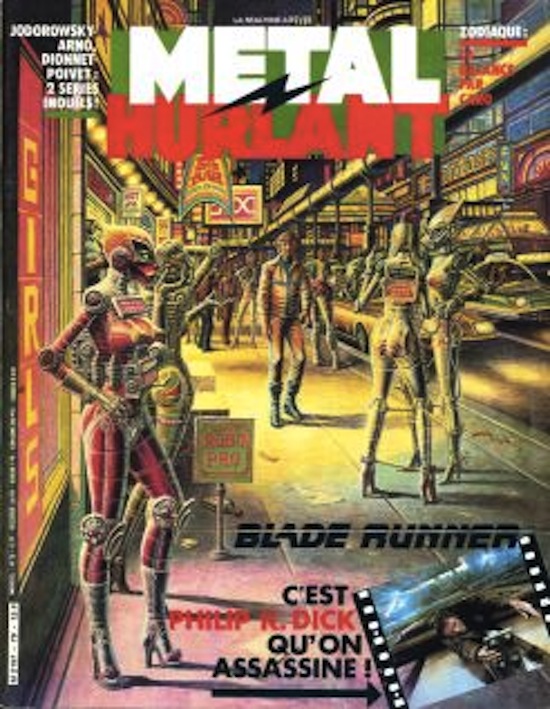
Métal Hurlant #79, cover by Ralph Reese
‘Mandryka, like Druillet, like Dionnet, like Moebius, they all came from Pilote, the comics magazine published by (Asterix writer) René Goscinny.’ Lecigne continues. ‘Because of the success of a lot of traditional comics – Asterix, Lucky Luke – it became possible for us and other new publishers to publish albums [books]. There were a lot of bookshops and comics specialists to carry them. Whereas now we publish 50-60 books annually (new titles plus new editions), at the beginning we published albums very slowly, maybe ten books in a year. Moebius’ Arzach and The Air-Tight Garage (which sees ‘science-fiction connoisseur’ Moebius using Michael Moorcock’s open source character Jerry Cornelius) were moderate successes.’
In 1981 everything changed. After visionary director Alejandro Jodorowsky’s plans for a film of Dune fell apart, he and Moebius (who storyboarded and worked on design for the movie) created a work that would change the face of both comics and science-fiction – The Incal. In the words of The Quietus’ own Mat Colegate: "Now this is a sexy, sexy thing…Plot wise, well, it’s written by Jodorowsky, innit? It’s batshit mental. The story barrels along, supporting the weight of its mysticism-soaked metaphors through pure damn-the-torpedoes chutzpah. Everything has some kind of oblique resonance. All the major characters represent one of the major arcana of the tarot pack (the lead character’s called John DiFool, for the love of The Priestess!) and most of the conflicts are solved by that classic pretentious sci-fi conceit of having the characters sit down to a bit of meditating and revealing of their true natures. It’s damn good fun, of course, but the main reason it enjoys such classic status is because it affords an opportunity to see one of the greatest artists in all comics history at the absolute peak of his game. Make no mistake, Moebius draws the hell out of this. Every situation visited upon the hapless characters is fully realised and breathtaking in scale. From trips to gigantic underwater cities and street fights in filth-encrusted urban locales, to, y’know, giant talking pyramids floating in space. It’s this sense of scale that really blows the head. Sitting down to read it this time, I was struck by how Moebius keeps a perfect sense of proportion, so that even the most insignificant members of the massive crowd scenes seem rich in life, to have realised back stories of their own and reasons for being where they are. Page layout, character design, and narrative flow combine to give a perfect example of comics at their absolute finest."
Lecigne: ‘It was completely new. It was completely modern to comics to do science-fiction like that. It was also another way to do comics.’ The way The Incal came into being is also astounding, perfectly in keeping with these two incredible artistic forces at the height of their powers. ‘The story was not written. The way it was done is something difficult to figure now. Both artists would meet together. Alejandro, with his background in theatre and as a director, would tell the story while Moebius sketched and took notes. Then Moebius does all the pages at home – it was possible for an incredible artist like Moebius to draw one page per day – he comes back to Alejandro, and they decide the final dialogues for the pages. Of course it was something very new. Later, when Jodorowsky does more comics, he writes scripts. But at the beginning it was done like that.’
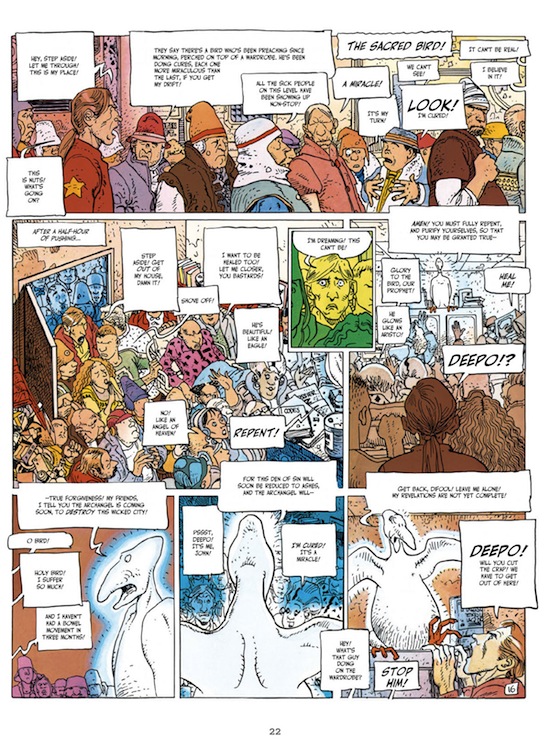
p. 22 of The Incal
‘The Incal was a very big success, and it’s success allowed Jodorowsky to do many other comics. Like Alef-Thau with Arno, The White Lama with George Bess. And many others, because he is very successful in most of the series he creates.’ The White Lama, long out of print in English, has been re-released in both hardcover trade and digitally this year. Set in late 19th Century Tibet, this story contains all the ingredients of a Jodorowsky classic. A grand lama is reincarnated as the young orphan son of white explorers and must struggle against the chaos and corruption enveloping his adopted land. Treacherous elements abound at all levels of society from sects to the global, familial ties are knotted in conflict, and of course we see all the wrackings spiritual transformation brings up the physical form.
Jodorowsky also greatly expanded the universe of The Incal. Working with artist Juan Gimenez, the two take us through the sprawling dynasty of The Metabarons in what Matt Fraction calls ‘THE story comics were created to tell’. And teaming up with Zoran Janjetov and Fred Beltran for The Technopriests, we’re given the epic origins of that formidable guild as Albino, the Supreme Technopriest, recounts his ‘cosmic odyssey’. Jodorowsky, Janjetov, and Beltran also produced Before The Incal, detailing the adventures of a young John DiFool.
The 90s saw Jodorowsky working again with Moebius for Madwoman Of The Sacred Heart, another awe-inspiring whirlwind of a tale featuring some of Moebius’ best artwork. Staid professor Alan Mangel thinks he knows something of spirituality but his inner youth, manifested as a hallucinatory green demon, is determined to show him what he’s missing. His young student Elisabeth seduces Mangel inside Sacré-Couer and with her believing their child will be the second coming of John The Baptist, they’re whisked from Paris to Israel in the company of drug addicts, escaped mental patients, and radical revolutionaries, before being swept off to the jungles of Columbia and the magical healing powers of bruja Doña Paz. It’s not exactly the merging of your light and dark sides as in The Incal, but rather uniting the energy of the mind with the intuition of the heart. And Jodorowsky and Moebius would begin to work together again on the world they created in 1981. More on this in a minute.
In 1987, magazine Métal Hurlant ceased its operations. Lecigne tells ‘It was a time of crisis for monthly comics magazines. In the past, that was the only way to produce comics but now the same comics that would appear in the magazines would very soon be published in books. There was much competition between the two products. Most of the readers finally preferred the books – you can collect the story in one album and it’s a more beautiful object. Métal Hurlant was a very big influence in the comics in France and abroad. [NOTE: Métal Hurlant and Heavy Metal were two completely separate magazines. Lecigne clarifies, ‘Heavy Metal took its inspiration from Métal Hurlant but that’s all. They’re only related because they published a lot of comics coming from Métal Hurlant.’] A big influence but not so big on sales. So it was one of the first magazines to stop. The other big magazines, Pilote, À Suivre, one after the other they have to stop too. And Les Humanoïdes Associés began to focus only on the books. One of Yves Chaland’s pages was very famous. It was in the last issue of Métal Hurlant, and was a celebration of the magazine from (Chaland’s character) Young Albert.’ Chaland, a very talented artist in his own right, also coloured the very first Incal story.

Yves Chaland’s tribute to Métal Hurlant
In 2002, Les Humanoïdes Associés/Humanoids publisher Fabrice Giger revived the magazine for thirteen issues, creating what Lecigne calls ‘a bridge between the Paris and Los Angeles offices’. Camille Thélot-Vernoux, LHA’s Literary Director, explains ‘Like the first period, it was a kind of laboratory to test new artists, new writers. And then we developed series with some of these artists ‘tested’ in the magazine.’ One such artist was Mexican-born Los Angeles resident José Ladrönn, whose collaboration with Jodorowsky, ‘Tears Of Gold’, was published in the penultimate issue, September/October 2004. Jodorowsky would write eleven short pieces for the new Métal Hurlant during this time, commenting ‘all writers know that it is much easier to write a thousand-page book than a short story’ (quote from intro of Screaming Planet in which these stories are collected). The stories are each drawn by a different artist with Jodorowsky choosing subject matter to both capitalise on the individual artist’s strengths as well as push their limits.
Jodorowsky and Ladrönn would go on to create Final Incal together, the conclusion to that game-changing saga. The last part of the Final Incal trilogy was released in French this year and all three volumes are now published in English for the first time. Thélot-Vernoux: ‘For us, it’s really the beginning of the celebration of the anniversary.’
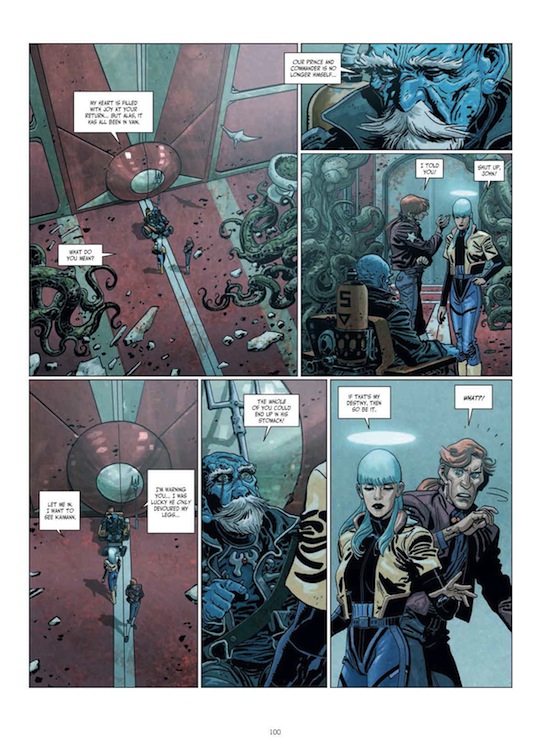
p. 100 Final Incal, art by José Ladrönn
And Final Incal is cause to celebrate. Opening on a different angle to the final panel of the original work (itself a callback to the second page of the very first book that sets everything rolling), John DiFool repeats those same words ‘I must remember’ as he plummets through suicide alley to the great acid lake below. Whilst keeping with the spiritual themes of the story, Final Incal goes even further into the societal aspects of the filth we must excavate, explore, and transform to find our true selves. A bio-destroying virus rapidly spreads, intent on eradicating all lifeforms and bringing about ‘metallic consciousness’ ultimate triumph’. John DiFool is thrown in the fray again, reluctantly embarking on a quest for the true love that will save the horror-filled Universe. But this isn’t sappy nonsense, at its heart is a battle between Life and Death, raging between their emissaries, some of whom are vast entities capable of fighting amidst multiple universes simultaneously. There is much compelling allegory here. Power never changes – the Supreme Leader’s brain, as in the initial series, is once again being transferred into yet another new body. Much is made of technology’s strangehold on us, the machines that we create or allow to be created now holding us prisoner. And when these robots attack human forms, they breed with them instantly. And of course coming from Jodorowsky, this all takes place on a galactic stage with DiFool at one point teaming up with three other incarnations of himself. Ladrönn’s artwork is excellent, keeping with the spirit of the original whilst presenting this new story in his own stylistic and modern way.
Speaking of that original art, when Jodorowsky decided to revive the Incal storyline, it was with Moebius back behind the pen. The two began work on a conclusion to the fable of DiFool, completing 56 pages before other commitments took Moebius away from the project. True to his pioneering artistic spirit, instead of merely finding someone to fill-in for Moebius to complete the task, Jodorowsky asked Ladrönn to ‘restart the entire story from the beginning’. But <After The Incal (‘The New Dream’), that first part begun with Moebius, also exists, available digitally and beautifully reprinted in the Oversized Deluxe Edition of Final Incal. Jodorowsky completely rewrote the script for Ladrönn but now being able to see the multiple aspects of the action between them creates even wider resonance to The Incal‘s life-affirming howl. In Moebius’ part, the addition of a shape-shifting savoir adds another dimension to the battle between the electronic vampire of the Benthacodon and the life-giving Elohim. When the Supreme Brain announces ‘put gas masks on sale’, the element of commerce is added to how technology, war, and those in control work together. Plus there’s good fun, like Deepo, that most loveable concrete bird, vomiting at different times within the two stories and thus saving the day. Moebius’ art in its more European style continues to seduce, delight, and astound.
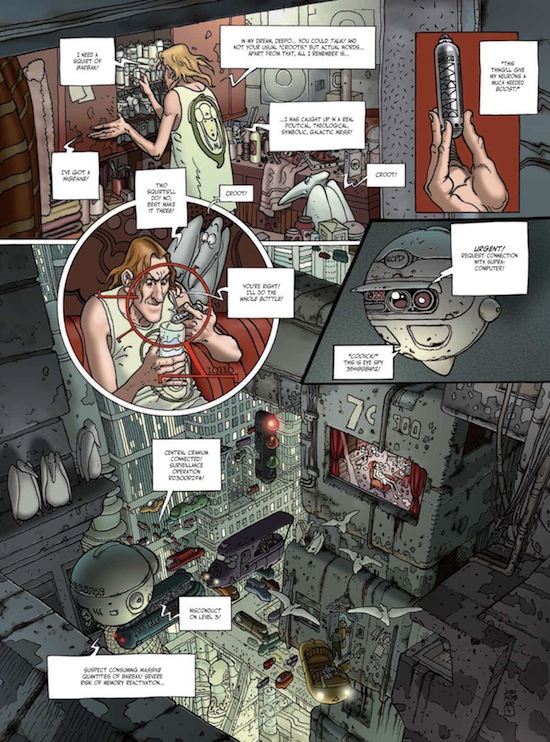
from After The Incal, art by Moebius
Besides Jodorowsky’s brilliant works, Humanoids publishes a wide range of sci-fi, horror, action/adventure, crime, and fantasy titles as well as a handful of erotica and humour books. A new English version of Barbarella was released this year. Humanoids Director of Marketing & Social Media Jo Witherington tells us ‘Barbarella‘s been put out in English before but the adaptation was too far apart from the French edition. We thought it well worth it to find someone who could adapt it better. Kelly Sue DeConnick’s version is very close to the original French.’
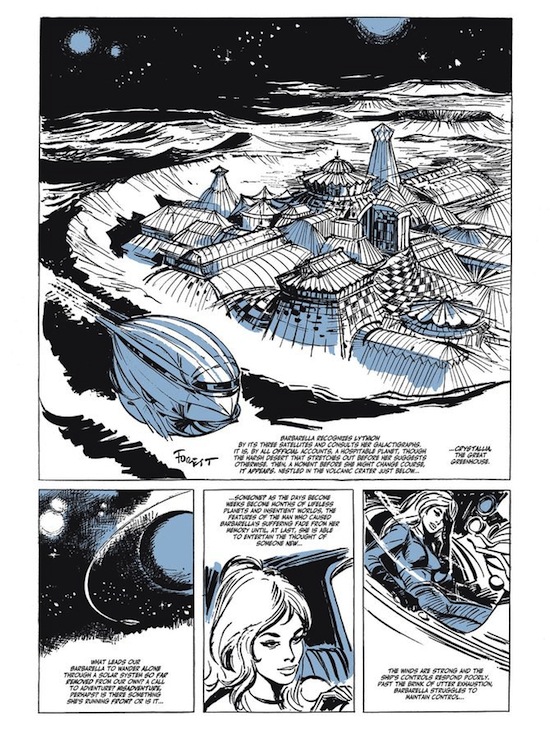
from Jean-Claude Forest’s Barbarella
2014 also saw the release of what would be the very first titles published by Humanoids UK. The story of Yann & Edith’s Basil & Victoria: London Guttersnipes is like a filthy Tintin transported to the Victorian-era London docks, while the art is more if Toulouse-Lautrec drew old-time comics for his posters. The young duo live by catching and selling rats with their dog Cromwell but can never resist a big caper in search of bigger money. These schemes bring them into contact with major themes and figures of the day – Dickens gets a mention, Dr. Watson appears in one of the stories, and young Victoria dreams of meeting her royal namesake. Although handled with a lightness of touch, often the titular pair find themselves in quite dark situations. The shadow of death looms large as they become entangled in the Jack The Ripper murders or the slave trade in Zanzibar (even en route a dead body is discovered in a barrel of the ship’s rum). And whilst obviously very much in love with each other, their humorous insecurities continuously bring third parties into the mix, including an episode where Victoria plots to kill Basil’s new crush. Eisner-nominated Nicolas de Crécy’s first work, Foligatto, written by Alexios Tjoyas, tells the story of the famous castrato of the title returning to his hometown of Eccenihilo to give a concert at the conclusion of its carnival. The festivities are being held in the hopes of curbing the citizens’ increasing violence, giving them a chance to blow off steam. But this old-style European city with its dingy, unsteady architecture enters the surreal once the celebrated singer arrives. A strange little fairy tale that flirts with darkness. I’ve sung de Crécy’s praises before in The Quietus, his The Celestial Bibendum and Salvatore stories are both wonderful works. Foligatto shows the beginnings of de Crécy’s Baroque-style which can perhaps best be described as ‘beautifully grotesque’ in the classical sense of the word.
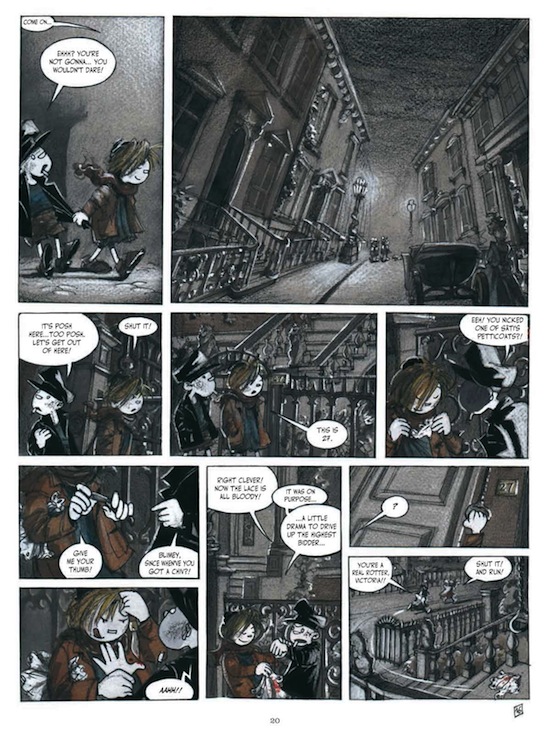
p. 20 Basil & Victoria
There are three titles to read for free on the Humanoids site this month. Judging by ‘Part One: The Teenage Years’, Milan K looks like it will be an excellent spy series. Mikhail Illitch Khodorov’s Russian billionaire father is set up by the state and imprisoned, leaving young Misha to be sent to an exclusive Swiss boarding school under the protection of trusted bodyguard Igor. The young boy just wants a normal life but President Palin (for the story is not without moments of humour) still has it in for the Khodorov family. Igor whisks Misha away to America in the nick of time and the boy must grow up fast, losing almost everything he loves. The description on the site offers ‘He would become one of the world’s wealthiest men, dedicated to fighting for the oppressed, the ones lacking voice or power. But his tactics would prove far different from that of the charities and other humanitarian organizations of his time. He was to wage a ruthless war, fraught with great victories and just as great defeats.’ So keep your eye out for more of this engrossing thriller.
For further books to explore, check out last December’s Comics Round-Up that was ‘hella heavy on Humanoids’. Featuring The Fantastic Voyage of Lady Rozenbilt and District 14 Season 2, both based around Pierre Gabus & Romuald Reutimann’s anthropomorphic world of corruption, sabotage, passion, benevolence, and the struggle for survival. There’s also reviews of Jodorowsky’s Screaming Planet, Philippe Riche’s Bad Break, and Saverio Tenuta’s awesome Legend Of The Scarlet Blades – ‘A haunting and haunted story of chilling beauty. A frozen world inhabited by ice wolves, samurai, peasants with magical knowledge and power, and ruled over by a once-deformed princess whose vanity has plunged their world into chaos and violence.’
There is far far more within the world of Humanoids than can possibly be included in the scope of this piece, but hopefully the above will take you through the doors and on your way to exploring their vast and fascinating universe. Here’s to 40 more years!

